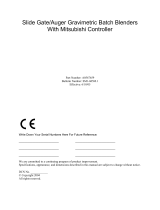
NORMAL OPERATING SEQUENCE - EACH CYCLE
As the sensor is uncovered, the cycle begins. The target weight of a
complete depends on model; 400, 1000, 2000, 4000, 9000, or 18000 grams.
REGRIND, if requested, will dispense first. After the Regrind dispense
the space remaining in the weigh bin is calculated.
NATURAL will dispense second. This dispense is calculated to fill the
bin leaving just enough space for the Color and Additive dispenses.
After the Natural dispense is complete the exact weight of this
dispense is calculated and, based on this actual dispense weight, the
Color and Additive dispenses are now calculated.
COLOR and ADDITIVE are now dispensed one at a time as requested. These
dispenses are a percentage of the Natural component only.
If the Natural, Color, or Additive components fail to reach the
requested weight, the process does NOT CONTINUE. The ALARM Strobe
light flashes and the system holds until the problem is remedied.
As each component is being dispensed and weighed, the corresponding
letter (R, N, C, or A) is displayed. The total updated bin weight is
displayed about 3 seconds AFTER each dispense.
Each dispense weight is checked and recorded. Rate recalibration takes
place every cycle to ensure continuous process accuracy.
The total batch is dropped into the mixing chamber and blended before
entering the throat of the process machine.
SPECIAL FEATURES
To use one of these SPECIAL FEATURES, read about it first, then follow
the directions on next page to make the proper changes.
To store RECIPES using the RECIPE storage feature, read:
KEYPAD, RECIPE key, and set 3rd digit in the FLG parameter to 1.
To blend a preset BATCH amount of material and then stop, read:
KEYPAD, BATCH key, and set 5th digit in the FLG parameter to 1.
To increase throughput, using the FAST key, read:
KEYPAD, FAST key, and set 4th digit in the FLG parameter to 1.
To TAG all material usage data with Work Order or Employee numbers for
better tracking of material used, read:
KEYPAD, TAG key, and set 2nd digit in the FLG parameter to 1.
BATCH, RECIPE, FAST, and TAG keys REQUIRE that you read:
PARAMETERS, FLG parameter.
To change the MIXER RUN TIME, read:
PARAMETERS, MIX Parameter.
Page 19






















